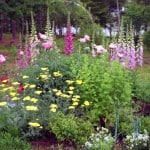It has been just over a year since I left my former garden to move to Poison Ivy Acres. For the third time in my life I’m starting with a blank canvas landscape and creating new gardens. It was therefore interesting to go back to my old property and walk the garden with the current owner.
The people who own the house how are not gardeners, but they appreciate the garden and are eager to learn and make it their own. As we walked around the small yard, I realized just how much a controlling hand is necessary in a garden, especially when there are so many “gardeners’ plants” on the property.
In addition to speaking, writing and hosting GardenLine on the radio, I frequently consult with local homeowners about garden design. In my head is a list of plants that I know will do well for these people, who are usually home landscapers, not gardeners.
The plants that I recommend for these clients are different from many of the plants I use in my own garden. I plant foxgloves, for example, and although these people might love how they look when the plant is in bloom, they would not be willing to do what I do in order to have them. I grow foxgloves from seed every year, and plant them in appropriate places. I also move those that have self-seeded into groups, and I tend all these plants through the summer so that I know that I’ll have a good show of Digitalis the following June.
Most of my clients, however, are not willing to start these biennials from seed. Foxgloves are gardeners’ plants, not home landscapers’ plants. My consultation customers want plants they can count on. I’ll recommend Russian sage, not delphiniums; peonies, not lupine; geranium ‘Rozanne’, not Gaillardia.
As I walked my old property I saw many plants that I loved, and was willing to raise from seed, relocate or fuss with. After just one season many were growing in the wrong spots. The tall Verbascums were clustered at the edges, instead of being transplanted into the center of the flowerbeds. Self-seeders such as Lychnis coronaria and Angelica archangelica have traveled to random places, including in the middle of the Russian sage. The circle flower that I thought I removed from the cottage garden was back, proving that there is no such thing as getting rid of a Lysimachia. The iris that I divided four years ago need it again.
The visit to my previous garden reinforced my practice of recommending one set of plants to my consultation clients, while growing another group in my own gardens. “What’s right for the goose isn’t always right for the gander,” the old saying goes, and what’s desirable for a gardener’s garden isn’t necessarily good for everyone else.



